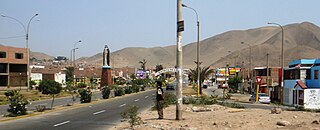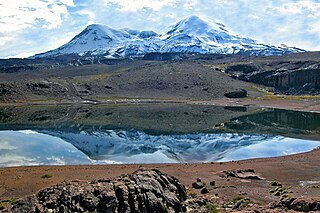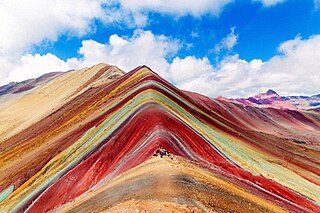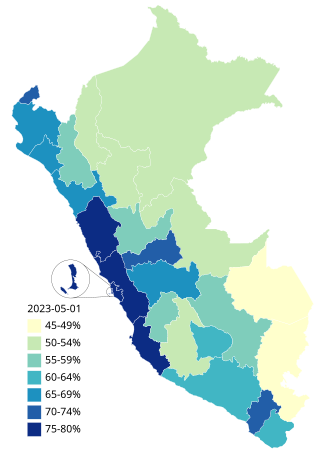Related Research Articles
The foreign relations of Peru are managed by the Ministry of Foreign Affairs. is an important first-tier state in South America, Peru has been a member of the United Nations since 1945, and Peruvian Javier Pérez de Cuéllar served as UN Secretary General from 1981 to 1991. Former President Alberto Fujimori's tainted re-election to a third term in June 2000 strained Peru's relations with the United States and with many Latin American and European countries, mainly small countries like Yemen but relations improved with the installation of an interim government in November 2000 and the inauguration of Alejandro Toledo in July 2001.

Santa Rosa is a district of the Lima Province in Peru. Officially established as a district on February 6, 1962. The district's postal code is 38. It limits to the north and the east with the Ancón District, to the west with the Pacific Ocean, to the south with the Ventanilla District.
Roger Najar Kokally is a Peruvian politician and a former Congressman representing Ucayali in the 2006–2011 term.

Susana Gladis Vilca Achata is a Peruvian politician and was a Congresswoman representing Puno for the 2006–2011 term. Vilca belonged to the Union for Peru party.

Yucamane, Yucamani or Yucumane is an andesitic stratovolcano in the Tacna Region of southern Peru. It is part of the Peruvian segment of the Central Volcanic Zone, one of the three volcanic belts of the Andes generated by the subduction of the Nazca plate beneath the South America plate. Peru's active volcanoes Ubinas, Sabancaya and El Misti are also part of the Central Volcanic Zone.

Auquihuato is a cinder cone in the Andes of Peru, 4,980 metres (16,339 ft) high. It is situated in the Ayacucho Region, Paucar del Sara Sara Province, on the border of the districts Colta and Oyolo. Auquihuato lies northeast of Sara Sara volcano.

Coropuna is a dormant compound volcano located in the Andes mountains of southeast-central Peru. The upper reaches of Coropuna consist of several perennially snowbound conical summits, lending it the name Nevado Coropuna in Spanish. The complex extends over an area of 240 square kilometres (93 sq mi) and its highest summit reaches an altitude of 6,377 metres (20,922 ft) above sea level. This makes the Coropuna complex the third-highest of Peru. Its thick ice cap is the most extensive in Earth's tropical zone, with several outlet glaciers stretching out to lower altitudes. Below an elevation of 5,000 metres (16,000 ft), there are various vegetation belts which include trees, peat bogs, grasses and also agricultural areas and pastures.
The Hope Front was a Peruvian political party. Founded in December 2015 by former congressman and government minister Fernando Olivera, he was nominated for the Presidency in the 2016 general election.

Vinicunca, or Winikunka, also called Montaña de Siete Colores, Montaña de Colores or Montaña Arcoíris, is a mountain in the Andes of Peru with an altitude of 5,200 metres (17,100 ft) above sea level. It is located on the road to the Ausangate mountain, in the Cusco region, between Cusipata District, province of Quispicanchi, and Pitumarca District, province of Canchis.

Ticsani is a volcano in Peru northwest of Moquegua and consists of two volcanoes that form a complex. "Old Ticsani" is a compound volcano that underwent a large collapse in the past and shed 15–30 cubic kilometres (3.6–7.2 cu mi) of mass down the Rio Tambo valley. Today an arcuate ridge remains of this edifice. "Modern Ticsani" is a complex of three lava domes which were emplaced during the Holocene. Two large eruptions took place during the Holocene, producing the so-called "Grey Ticsani" and "Brown Ticsani" deposits; the last eruption occurred after the 1600 eruption of neighbouring Huaynaputina. The volcano is seismically active and features active hot springs and fumaroles; since 2015 the volcano is monitored by the Peruvian government.

Ubinas is an active stratovolcano in the Moquegua Region of southern Peru, approximately 60 kilometres (37 mi) east of the city of Arequipa. Part of the Central Volcanic Zone of the Andes, it rises 5,672 metres (18,609 ft) above sea level. The volcano's summit is cut by a 1.4-kilometre-wide (0.87 mi) and 150-metre-deep (490 ft) caldera, which itself contains a smaller crater. Below the summit, Ubinas has the shape of an upwards-steepening cone with a prominent notch on the southern side. The gently sloping lower part of the volcano is also known as Ubinas I and the steeper upper part as Ubinas II; they represent different stages in the volcano's geological history.

The Colombian Geological Survey (CGS) is a scientific agency of the Colombian government in charge of contributing to the socioeconomic development of the nation through research in basic and applied geosciences of the subsoil, the potential of its resources, evaluating and monitoring threats of geological origin, managing the geoscientific knowledge of the nation, and studying the nuclear and radioactive elements in Colombia.
Purupuruni is a group of lava domes in southern Peru and a correlative geological formation. They are among the many volcanoes that exist in Peru and whose activity has been associated with the subduction of the Nazca Plate beneath the South America Plate. Purupuruni is associated with a geothermal field and a caldera. Volcanic activity occurred during the Pleistocene 53,000 ± 8,000 years ago but also during the Holocene about 5,300 ± 1,100 years ago; today the volcano is considered to be a low hazard volcano but is being monitored nevertheless.

The Chief of the Joint Command of the Peruvian Armed Forces is the professional head of the Peruvian Armed Forces. He is responsible for the administration and the operational control of the Peruvian military.

María Luisa Aguilar Hurtado, was the first professional astronomer of Peru. She studied at the Institute of Mathematics and Physics of the National University of San Marcos in Lima, Peru. She graduated as an astronomer from the National University of La Plata, Argentina. In 1981, motivated to develop astronomy at a professional level, she founded and served as director of the "Astronomy and Astrophysics Seminar", nowadays called "Permanent Astronomy and Space Sciences Seminar" of the National University of San Marcos.

The COVID-19 vaccination program in Peru is the national vaccination strategy to protect the population against SARS-CoV-2 employing vaccines developed for the COVID-19 pandemic in Peru. Vaccination began on 9 February 2021, after three days of arrival of first vaccines. On a nation message, the head of state Francisco Sagasti confirmed the purchase of 38 millions of vaccines, being one million of vaccines for health personnel.
Paul Gabriel García Oviedo is a Peruvian businessman and politician. Currently, he is a Congressman, representing Callao since March 16, 2020.

Guido Bellido Ugarte is a Peruvian politician of Quechua heritage, an electrical engineer and economist. He served as prime minister of Peru from 29 July to 6 October 2021. He is also serving as a member of the Congress, representing Cuzco.
Rosalvina Rivera (1914–2011) was a Peruvian palaeontologist who dedicated her entire life to studying geology in Peru. She was the first woman in Peru to receive the title of doctor in geology.
References
- 1 2 "Quiénes Somos - Ingemmet". www.ingemmet.gob.pe (in European Spanish). Archived from the original on 2020-10-07. Retrieved 2018-07-22.
- ↑ "Observatorio Vulcanológico del INGEMMET (OVI) – Observatorio Vulcanológico del INGEMMET". ovi.ingemmet.gob.pe (in European Spanish). Archived from the original on 2016-06-27. Retrieved 2018-07-22.